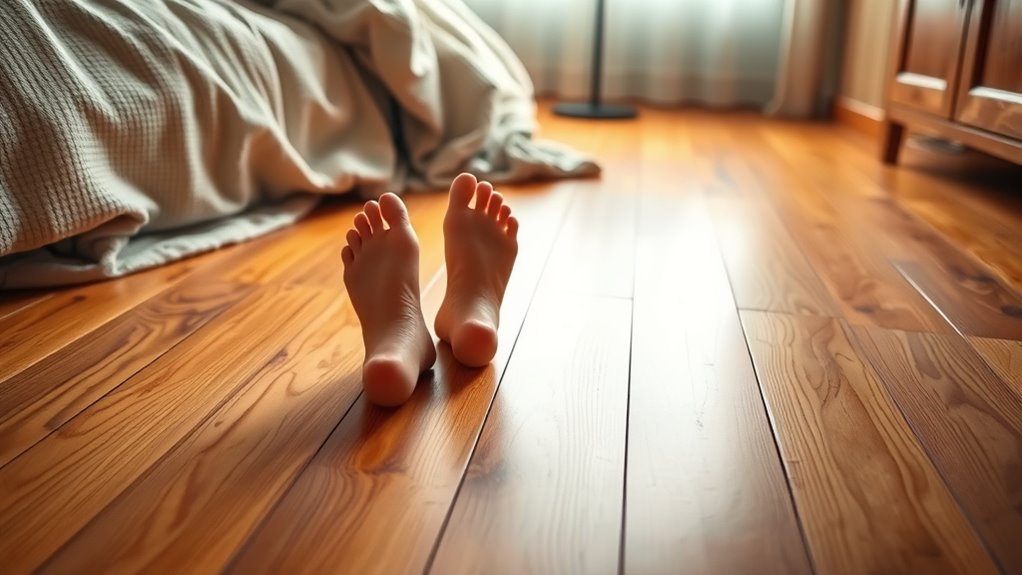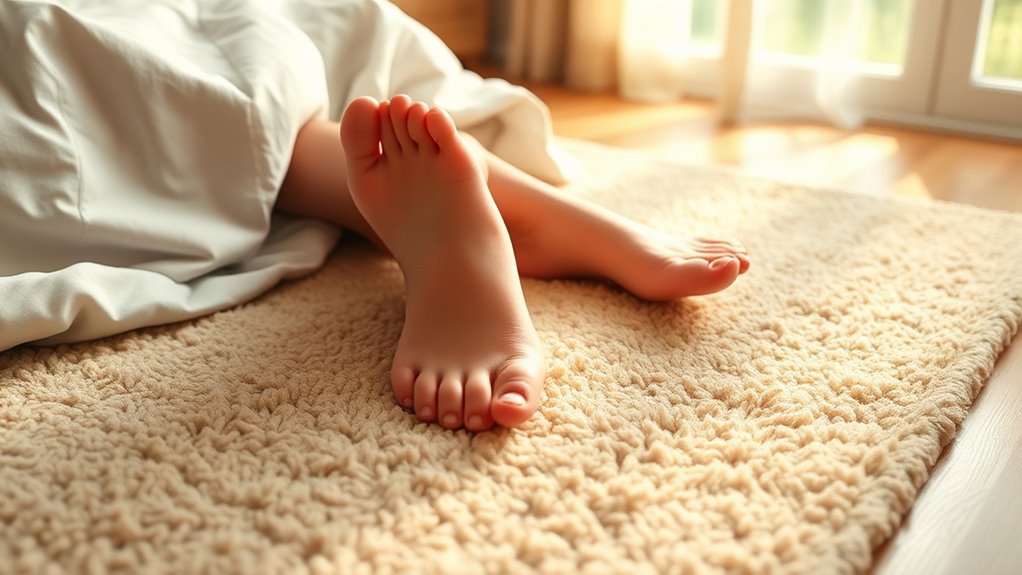Maintaining a warm floor helps keep your feet cozy, which can improve your overall comfort and promote better sleep. Cold floors may cause discomfort, restlessness, and difficulty relaxing. Modern heating systems let you control your floor temperature precisely, ensuring even warmth and energy efficiency. When your feet stay warm, your body relaxes more easily, leading to deeper, restorative sleep. Keep exploring to discover how proper floor temperature can transform your comfort and health even further.
Key Takeaways
- Warm floors provide a cozy environment that promotes relaxation and helps improve sleep quality.
- Proper floor temperature reduces cold feet, minimizing restlessness and making it easier to fall asleep.
- Consistent, comfortable warmth decreases bodily stress, supporting healthier sleep cycles.
- Advanced heating systems allow precise control of floor temperature, enhancing overall sleep comfort.
- Maintaining optimal floor warmth creates a peaceful atmosphere, encouraging restful and restorative sleep.

Keeping your floor temperature in check is essential for comfort and safety. When your floors are too cold, it can make your entire room feel chilly and uninviting, especially during colder months. On the other hand, a warm floor can create a cozy environment that enhances your overall sense of well-being. That’s where heated floors come into play. These systems are designed to provide consistent warmth directly beneath your feet, helping you achieve ideal thermal comfort throughout your living space. By maintaining a steady, comfortable temperature, heated floors eliminate cold spots and drafts that often disrupt your comfort and sleep quality.
Thermal comfort isn’t just about feeling warm; it’s a key factor in your overall health and well-being. When your feet are cold, your body works harder to generate heat, which can lead to discomfort and even impact your sleep. Cold floors can cause you to feel restless, making it harder to fall asleep or stay asleep through the night. Conversely, a warm floor creates an inviting atmosphere that signals to your body it’s time to relax. This sense of warmth can help lower stress levels and promote better sleep cycles. Investing in heated floors ensures you’re not only comfortable during the day but also setting the stage for restful, restorative sleep.
Controlling your floor temperature is more straightforward than you might think. Modern heating systems allow you to tailor the warmth to your preferences, often with programmable thermostats that let you set specific temperatures for different times of the day. This level of control helps conserve energy and reduces utility bills, making heated floors both a practical and luxurious upgrade. Plus, they distribute heat evenly across the entire surface, eliminating cold patches that can cause discomfort or even lead to cold-related health issues. The consistent warmth creates a stable environment, so you don’t have to worry about sudden cold drafts sneaking in or uneven heating.
When you prioritize your floor’s temperature, you’re directly influencing your comfort and sleep quality. A warm, inviting floor can turn your living space into a sanctuary of thermal comfort, especially during winter. It’s an investment that pays off by making your home more comfortable, energy-efficient, and healthier. Whether you’re lounging at home or winding down for bed, a heated floor helps you maintain the perfect temperature, ensuring your feet stay warm and your sleep remains undisturbed. Additionally, understanding cheating and its impacts can help promote honesty and trust within relationships, fostering a healthier environment both emotionally and physically. Ultimately, paying attention to your floor temperature isn’t just about comfort; it’s about creating a healthier, more restful environment you’ll look forward to returning to every day.
Frequently Asked Questions
Can Floor Heating Improve Sleep Quality for All Age Groups?
Floor heating can improve sleep quality for most age groups, as a warm surface helps regulate body temperature. To maximize benefits, guarantee proper floor insulation, which enhances energy efficiency and maintains consistent warmth. This consistent heat creates a cozy environment, making it easier to fall asleep and stay asleep. While it’s beneficial for many, always consider individual needs and health conditions for ideal comfort and sleep improvement.
How Quickly Does Floor Temperature Affect Sleep Onset?
Think of your body as a thermostat, quickly responding to its surroundings. When you adjust the floor temperature, your thermal response kicks in, influencing sleep latency. You might notice that warmth underfoot can help you drift off faster within 15 to 30 minutes. The right floor temperature acts like a gentle lullaby, easing your shift into sleep by stabilizing your body’s thermal regulation and shortening the time it takes to fall asleep.
Are There Health Risks Associated With Overly Warm Floors?
You might wonder if overly warm floors pose health risks. While comfortable warmth can improve sleep, excessively hot floors could cause issues like burns or skin irritation, especially for vulnerable individuals. To guarantee floor safety, consider insulation considerations that prevent heat from becoming too intense. Keep the temperature moderate to enjoy cozy warmth without risking discomfort or health problems, and always check the flooring’s heat tolerance.
What Types of Flooring Are Best for Maintaining Optimal Floor Temperature?
Your floors can make or break your comfort, so choosing the right type is vital. Radiant flooring, like hydronic or electric systems, effectively maintains warm, cozy surfaces. Pair it with quality insulation materials to prevent heat loss and keep your floors at an ideal temperature. Hardwood and tile are excellent choices, as they retain warmth well. With the right combination, you’ll keep your feet warm and your home energy-efficient.
How Do External Temperatures Influence the Effectiveness of Floor Warming?
External temperatures markedly influence how well floor warming works. When outdoor climate is cold, proper thermal insulation becomes essential to retain heat and prevent it from escaping. Without adequate insulation, even the best floor warming systems struggle to maintain a comfortable temperature. You should consider insulation above or below the heating elements, especially in colder climates, to maximize efficiency and keep your feet warm regardless of outdoor conditions.
Conclusion
Remember, just as the warmth of a hearth invites comfort and rest, maintaining a cozy floor temperature can transform your sleep. By ensuring your feet stay warm, you create a sanctuary where dreams flourish and stress melts away. Think of it as tending a small fire—when you nurture warmth at the roots, everything above blossoms. So, take control of your comfort tonight and let the gentle heat guide you to a peaceful, restorative sleep.









